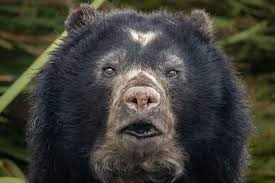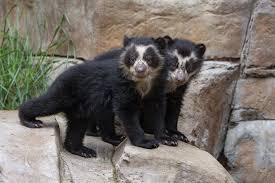This week we are looking at the Andean Bear also known as the
Spectacled Bear, this is a species of bear native to the Andes Mountains in
northern and western South America. It is the only living species of bear
native to South America, and the last remaining short-faced bear.
The bears are an endangered species, listed as Vulnerable, and
it is illegal to kill them. The Andean bear is the last remaining short-faced
bear spectacled bears are the only surviving species of bear native to South
America, and the only surviving member of the subfamily Tremarctinae.
They are technically the largest land carnivore on that
continent, although as little as 5% of its diet is composed of meat. South
America’s largest obligate carnivore is the jaguar. Among South America’s
extant, native land animals, only the Baird’s and South American Tapirs are
heavier than this species. They are a mid-sized species of bear.
Overall, its fur is blackish in colour, though bears may vary
from jet black to dark brown and to even a reddish hue. The species typically
has distinctive, beige-coloured marking across its face and upper chest, though
not all Spectacled bears have “spectacle” markings. The pattern and extent of
pale markings are slightly different on each individual bear and bears can be
readily distinguished by this.
They are relatively small compared to other bear
species.
Males typically weigh between 220-440 pounds and are 5.5 to 6.5
feet long, while females weigh between 80-180 pounds and are slightly
smaller. They stand 2 to 3 feet tall at the shoulder.
They have relatively large heads compared to their body size, as well as powerful claws and paws that help them climb trees and build nests. Despite their size, they are known for their adaptability to different environments within the Andes, from cloud forests to coastal deserts.
They inhabit mountainous regions of South America,
primarily the Andes Mountains, from Venezuela to Bolivia. They are found
in a variety of habitats including rainforests, cloud forests, grasslands,
and even scrublands. They are known to build platform nests in trees for
eating and sleeping and are generally active year-round.
They feed on fruits and
bromeliads being there favored foods, but also eat berries, grasses, bulbs,
cactus flowers and small animals such as rodents, rabbits and birds. Near
settlements, bears sometimes raid cornfields. Andean bears climb trees and
forage on the ground.
They have a lifespan of around 20yrs in the wild but up to about
38yrs under human care they have a gestation of between 160 to 255 days and can
have between 1 and 4 cubs they are considered mature between 4 and 7 years.
They are the only bears are the only known to eat bromeliads.
Has rings of white or light fur around its eyes. The rest of the bear's fur is
black or dark brown.
Andean bears, also known as spectacled bears, are generally
considered one of the least aggressive bear species towards
humans. While they are capable of defending themselves if threatened, they
typically avoid encounters with people and are known for their shy and elusive
nature. Attacks on humans are rare, with only one confirmed human death
attributed to a spectacled bear. They can run up to 30 mph.







Interesting, they don't appear to have a really nice face, Jo-Anne. Well that's in my thinking only.
ReplyDeleteI thought they have a pissed off look
DeleteThat's one I have never heard of. Interesting.
ReplyDeleteSame here
DeleteThey certainly stand out wearing their "spectacles." I had no idea that so many different species of bears existed. Blessings, Jo-Anne!
ReplyDeleteThere are eight main species and other sub-species
DeleteHadn't heard of this one before. Had to google bromeliads. Not a plant we have around here, that's for sure. Much nicer than our bears as far as percentage of attacks on people. Grizzlies are ones to watch out for the most, but the black bears can sometimes take offense or feel trapped, too. Most of the grizzlies are farther west than North Dakota, thank goodness. But black bears are all over the Midwestern states. Every once in a while we get one in town they have to trap and cart off to some woods far away. :)
ReplyDeleteI didn't know what bromeliads were either, there are no bears in Australia thankfully
DeleteVery interesting. I have never heard of them but they certainly have a very cute face.
ReplyDeleteCute maybe in a pissed off way, in my opinion
DeleteSpectacled bears I knew. Bromiliads I hadda look up.
ReplyDeleteI also had to look up what it was
Delete